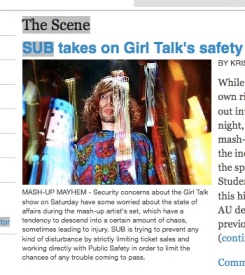As the semester winds down and we turn out our final issues, our beloved professor sets the tone.
David Johnson, hard at work… hard at work?
Cross-posted at Blog/19 and AmericanObserved.
Filed under: Russ | Tags: American Observer, David Johnson, District Newswire, yardstick
After the barn-burner of a post I just made, how about something lighter. Like how our work compares to everyone else’s.
Remember those broadcast people in our program? They do a full-scale TV news magazine every week. It’s pretty good. Sometimes it’s in Spanish. And wow, when did Annie Aho get that TV lady voice?
Our undergraduate friends at the Eagle, are plugging along too, helping us understand how not to write a cutline (click to see it bigger.)
Surfing away from the AU world, I think it’s useful to compare what other J-school grad students are doing as a yardstick to figure out what we’re doing right and wrong. We’ve hit something of a slump, but I think we’re comparing well.
The Columbia Journalist looks just like it did last semester, and it’s pretty spare – so is our site, but we kick it up with a broad Flash package which really helps. It’s also nice to see they have the same problems writing good headlines.
Columbia also has the “nyc24” which seems to be somewhere between the Journalist’s “city news” focus, and our focus on everything. Well, according to the school’s official Web site it’s focused around “GRIT,” whatever that means. I also broke their rules, by pronouncing it, “N-Y-C-TWENTY-FOUR.” That’s how we do in the Blogosphere.
Anyway, they definitely do some interesting Flash presentations to weave together some multimedia work, for any of you who are interested in that kind of thing. This is my favorite. Kind of choppy, and a little disorienting, but interesting. This one goes over the top, but really, when you’re talking about bail-bondsmen how can you not? It also gets points from me for following up on my favorite HBO show ever. But HBO did it better.
And for anyone who might be counting, or grinding his axe, Medill’s D.C. reporting program starts up again tomorrow.
Cross-posted at Blog/19 and AmericanObserved.
Filed under: Russ | Tags: American Observer, AU SOC, cross-posted, Publicity
For devoted readers of the AmericanObserved blog, you’ll know I’ve long had a chip on my shoulder about the placement of the Observer on the AU SOC’s Web site. Well, the school has a new Web site, and so does the SOC. The content isn’t dramtically different, although it looks a littl more modern. There’s a “Student and Faculty” work page – it’s still “dynamic” and OUR student work isn’t exactly prominent. We do have a permanent link on the bottom of several pages, and a couple shout-outs throughout the site, which is nice.
Last time I complained about our lack of visibility on the SOC Web site, it got a fairly quick response, which summed up was: you have to tell us you want attention because we’ve got a lot going on. This time they’re making it easier: there’s an easy link to submit “user content” to the SOC Web site. The ability to submit “user content” may be the development that will prevent us from getting jobs in August, but let’s use it to our advantage today.
Cross-posted at Blog/19 and AmericanObserved.
My goal with this blog was to talk about the Observer, not my personal pet peeves or uninformed opinions about journalism, but I’m going to venture into Twitter territory today. I’m generally fairly skeptical of its application as a news tool – great for (self-)promoting, and okay for news-gathering. My blog-mate Anna will heartily disagree. Probably via a tweet. The Observer has its own Twitter account, which has recently been picked up as a promotional tool. But, we, in general, should be careful about relying too heavily on it as reliable source for our news-gathering. While it has been helpful during some dramatic, hard-to-cover news events, and we’ve used it for our reporting, it has also been “helpful” spreading hysterical, un-true rumors during these panicky economic times. For example, yesterday, the rumor that the New Yorker was going to twice-a-month was re-Tweeted all over. This time the rumor was stopped in its tracks, but like on the Internet, the rumor remains archived and ready to rise again, represented as fact. Also, bad for us and for Twitter – it made Jennifer Aniston break up with John Mayer. Allegedly. Cross-posted at Blog/19 and AmericanObserved.
Filed under: Anna | Tags: American Observer, copyright, creative commons, cross-posted
That last week’s issue of the Observer was one of the best so far. All of the articles were interesting, the podcast went off without a hitch, and we even had time to do a “behind the scenes” video. I’m very impressed.
Of course, I should also mention that I committed an amateur’s mistake when putting together my breakfast taco video. I needed music for the background, so I went and found a song by Los Lobos and put it in there. I credited the artist, but when I went back and read the terms of use, it explicitly said DO NOT USE THIS MUSIC EVERRRRR THAT WOULD BE STEALING!!
Which, honestly, was kind of annoying, because if you find an mp3 easily available for download, and you credit the artist and don’t try to pass it off as your own work, shouldn’t that be okay? I’m obviously a big fan of creative commons licensing, and for a simple reason: It makes sense. I have yet to go back and plug in new music, but I obviously had to take down the video until I get a chance to do that.
Copyright law is, as we know, super complicated, and it is the only reason I would want to go to law school: To study and eventually fight for or against it. But that’s a subject for another day.
I’d be interested to hear what my fellow Observers think about Creative Commons, though.
Food for thought, watch Larry Lessig’s talk from TED.
Cross-posted to Blog10 and Escapador.
Filed under: Anna | Tags: American Observer, contributions, cross-posted, jane hall
This week the American Observer tackled the weighty issue of lobbying in D.C… or rather, lobbying in general, including the new laws and a history of modern advocacy.
Unfortunately, as Russ mentioned earlier this week, several of us were tied up in editing and choosing decent advocate profiles from a giant pile sent to us by Jane Hall’s Advanced Reporting class. Out of the 15 or so that were submitted, we chose to publish four. Kind of sad, huh? Well… I think we could have curbed our problems with the articles if we had laid out the following guidelines:
- Contributions have to be well-sourced. All of these profiles had a single source, which, had we published them without editing, would have sounded as if the American Observer was advocating them, too. We can’t have that.
- We need to know EXACTLY what the stories are before we agree to receive contributions. Apparently Professor Hall told her students it was okay to only speak to one person as the source for the piece… had we known that, we would have said no from the beginning and saved everyone a lot of time and work.
- Art is required. Since the beginning of the semester, we decided to make the Observer more magazine-y and multimedia heavy. That means art. Give us a photo, a graphic, whatever… just give us SOMETHING.
So that’s what I think. As managing editor for the past week, I was very involved in the entire process, so consider it a word from the experienced, and now the wiser.
Cross-posted to American Observer and Escapador.
I know Russ talked about our issue with deadlines a couple of times last week, but I wanted to weigh in on the issue as, well, sort of a devil’s advocate.
We produce an issue every Wednesday, the middle of the week. After signing up for stories, most of us have one or two classes that afternoon and/or night, usually lasting into the evening. So that afternoon is shot. The next two days are filled with classes and work, which doesn’t allow much time dedicated for stories, at least not in-person interviews, which we would prefer.
That means that most articles are written during the weekend (not business hours, obviously) or on Monday. We have very talented writers in our program, but given that our deadline is usually late Monday night, one day to write a story can be difficult, especially when we demand heavy multimedia.
Since I am the Flash-0bsessed member of our cohort, this can be even more frustrating. Flash takes time. Not even that… creating the wireframes to base the Flash on takes time. Design takes more time. Execution… even more. I posted last week on my blog that I was creating a timeline for Black History Month, but unfortunately my Monday and Tuesday were completely filled with work, and even though the reporter got the information to my by Tuesday afternoon, having everything ready to go by publish time on Wednesday was next to impossible. Coffey did me a favor by pulling the plug on that one, otherwise I would have been even more stressed out and tired come production time.
I suppose my point of this entry is to remind people that the American Observer is not the only thing we do, and that perhaps our problem isn’t meeting deadlines, but rather communicating to editors when we have problems. I like that we have started teaming up to cover stories so that the responsibility doesn’t just fall on one set of shoulders. I think that’s an easy first-step to our problem.
So take heart, Observers and Observer fans. This is a learning process.
Cross posted to Escapador and American Observer.
Filed under: Russ | Tags: American Observer, Amy Eisman, AU SOC, cross-posted, David Johnson, deadlines, video
There’s been quite a bit of talk about meeting deadlines lately. Here’s more.
David Johnson sent us a rather gentle (in my opinion) email this week about meeting deadline:
“It is important that your stories are filed with enough time for production. If you don’t respect the deadlines, you are disrespecting your colleagues and abusing their time on class day.
File your content.”
He’s right, and frankly, this is the nicest thing an editor will ever say to you about making deadline.
When you’re still working on something Wednesday morning, that means a copy editor is sitting around waiting for you to finish… a multimedia person is creating a graphic that might be all wrong or just doesn’t fit with the content that’s coming… and you’re not helping produce the issue.
Does anybody notice? Maybe not. But after you graduate, someone will.

